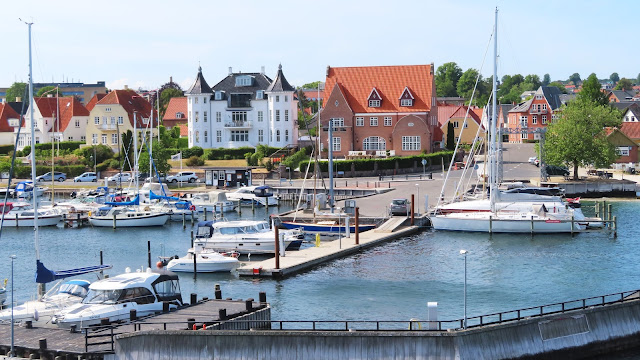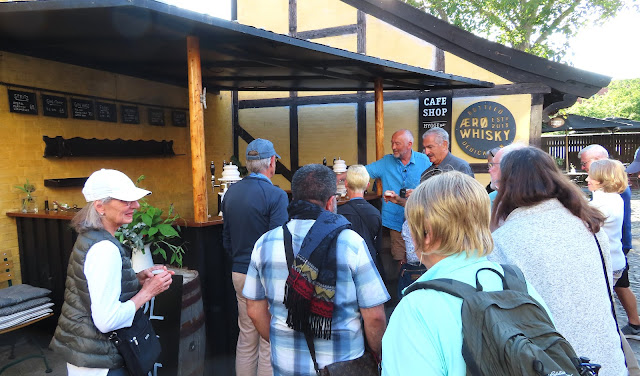June 9 - Roskilde and Ærø Island, Denmark
We left Copenhagen bright and early for a long travel day, but one of the things I love about Rick Steves Tours is that even the travel days include stops at interesting sites. Today, we stopped in Roskilde for the Viking Long Ships Museum and the Roskilde Domkirke (Cathedral), which is a UNESCO World Heritage Site.
 |
| The Viking Ships Museum |
 |
| Roskilde Cathedral |
I didn't know anything about Roskilde before our visit, but soon discovered that it has an important historic place in Danish history. It was a major stop on the Viking trade routes and served as the capital of Denmark from the 11th century until 1443.
We first toured the Viking Ships Museum, the home of the Skuldelev Ships, five original Viking ships that were discovered in 1962, buried in the mud of the bay. History records that they were deliberately sunk here in Roskilde Fjord in around 1070 in order to block the harbor and protect Roskilde from enemy attack.
The museum's website explains this history: "During the late Viking Age, a system of barriers are established on Roskilde Fjord, making it possible to control the sea routes to one of Denmark's great royal and ecclesiastical cities.
Three worn-out ships are towed out to the narrowest point, just outside the village of Skuldelev. The ships are filled with stones and sunk in the sailing channel Peberrenden, which is the most direct route to Roskilde. After twenty years, the barrier is reinforced with two more ships. An effective defence system is created.
A thousand years later an iron cofferdam is driven into the seabed around the barrier. One of the most significant excavations in Denmark can begin." |
| Roskilde Fjord |
The recovered ships were not well-preserved, so what we saw in the museum were reconstruction of the five ships using the bits of wood and hardware that were recovered. The ships were each different, ranging from cargo ships to warships, but archaeologists were able to discover a lot about how these ships were constructed.
 |
Skuldelev 1 is large ocean-going cargo ship from Sognefjord in western Norway. The ship is built of heavy pine planks and has a rounded form that gives it a high loading capacity and great seaworthiness on the North Atlantic. |
 |
Skuldelev 3 is a small, elegant, and sturdy trading ship, built for transporting goods in Danish coastal waters and the Baltic. The ship is the best preserved of the five Viking ships found in Roskilde Fjord and was built of Danish oak.
|
 |
| The recovered pieces of wood were fitted together on the reconstructed ships, then the shape of the missing parts of the ship were constructed of metal bars to show the original size and shape. |
 |
Skuldelev 2 is the large longship, a war machine, built to carry many warriors at high speed. With a crew of 65-70 men, it was a chieftain's ship, like those praised in ancient scaldic verse and sagas.
Skuldelev 5 is one of the smallest longships in a war fleet and is ideal for sailing in Danish coastal waters and through the short, choppy waves of the Baltic. |
 |
| Tools recovered from the sunken ships |
 |
| Model ships showed the original appearance of the Viking ships |
 |
| Informational poster about the Skuldelev ships |
Archaeologists have reconstructed one of these ships, Skuldelev 2, using the same types of woods and methods. It was dubbed "Sea Stallion" and has sailed to several cities in Europe.
 |
| The Sea Stallion alongside the special exhibits and workshops |
Several interesting displays of other items from Viking times and informational posters discussed life in the Middle Ages and the history of Roskilde.
There was also a room of costumes and some full-size ships to give visitors a taste of Viking life. Linda and I took advantage of this fun opportunity.
 |
| Viking Clothing |
 |
| Two Viking Maidens |
Outside the museum were several huts where both kids and adults were practicing their own woodworking skills and building little boats.
Our group went into Roskilde town for lunch of great deli sandwiches, and a little walk down the main street of the town.
 |
| Jerry, Carla, Raymond, Bruce and Mary at lunch in Roskilde |
 |
This cute little duck came begging for a handout. How could I refuse that face?
|
 |
| The pedestrian Main Street of Roskilde |
 |
| Town Square in Roskidle |
 |
| Fountain in the town square |
 |
| Roskilde Museum |
After lunch, some of our group visited the beautiful Roskilde Cathedral, which was built in 1170 by Absalon, the Danish bishop who also founded Copenhagen. The Gothic cathedral was completed in 1275 by Absalon's successors and it now contains the gorgeous tombs of 39 Danish kings and queens of the Middle Ages.
A crowd gathered at 1:00 to watch St. George slay the dragon on a medieval clock that still moves and chimes after hundreds of years.
 |
| St. George and the Dragon Astronomical Clock |
We ended our drive with an enjoyable ferry ride under sunny skies that took us to the town of Ærøskøbing on the lovely island of Ærø, where we would spend the next day.
Once in the town of Ærøskøbing, we settled into our hotel rooms. Laurel had arranged a downstairs room for me at our hotel, På Torvet...and it turned out to be a suite, with bedroom, living room with kitchenette, and bathroom. I felt a little guilty, as it was definitely meant for a couple, but I appreciated her thoughtfulness, since my hands were still having quite a bit of pain, so carrying bags upstairs would have been difficult.
In the early evening, we met our guide, John, an Englishman who had married a Danish woman and settled here, and he gave us a little walking tour of the neighborhood. We learned that, due to the business created by his wife, Louisa, Ærø has become one of the premier wedding venues in all of Scandinavia! We ended the tour in a tiny brewery that makes Ærø whiskey where we learned how to skål properly. (You must maintain eye contact throughout the toast. Some of us got the giggles as we stared intently into one another's eyes.) The day ended with a nice dinner at Mumm Restaurant.









































































No comments:
Post a Comment